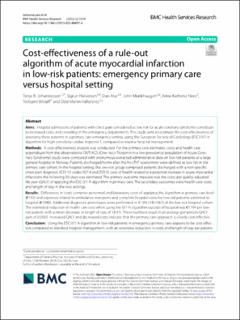| dc.contributor.author | Johannessen, Tonje Rambøll | |
| dc.contributor.author | Halvorsen, Sigrun | |
| dc.contributor.author | Atar, Dan | |
| dc.contributor.author | Munkhaugen, John | |
| dc.contributor.author | Nore, Anne Kathrine | |
| dc.contributor.author | Wisløff, Torbjørn | |
| dc.contributor.author | Vallersnes, Odd Martin | |
| dc.date.accessioned | 2022-11-18T07:59:43Z | |
| dc.date.available | 2022-11-18T07:59:43Z | |
| dc.date.created | 2022-10-24T09:35:22Z | |
| dc.date.issued | 2022 | |
| dc.identifier.issn | 1472-6963 | |
| dc.identifier.uri | https://hdl.handle.net/11250/3032710 | |
| dc.description.abstract | Aims: Hospital admissions of patients with chest pain considered as low risk for acute coronary syndrome contribute to increased costs and crowding in the emergency departments. This study aims to estimate the cost-effectiveness of assessing these patients in a primary care emergency setting, using the European Society of Cardiology (ESC) 0/1-h algorithm for high-sensitivity cardiac troponin T, compared to routine hospital management. Methods: A cost-effectiveness analysis was conducted. For the primary care estimates, costs and health care expenditure from the observational OUT-ACS (One-hoUr Troponin in a low-prevalence population of Acute Coronary Syndrome) study were compared with anonymous extracted administrative data on low-risk patients at a large general hospital in Norway. Patients discharged home after the hs-cTnT assessment were defined as low risk in the primary care cohort. In the hospital setting, the low-risk group comprised patients discharged with a non-specific chest pain diagnosis (ICD-10 codes R07.4 and Z03.5). Loss of health related to a potential increase in acute myocardial infarctions the following 30-days was estimated. The primary outcome measure was the costs per quality-adjusted life year (QALY) of applying the ESC 0/1-h algorithm in primary care. The secondary outcomes were health care costs and length of stay in the two settings. Results: Differences in costs comprise personnel and laboratory costs of applying the algorithm at primary care level (€192) and expenses related to ambulance transports and complete hospital costs for low-risk patients admitted to hospital (€1986). Additional diagnostic procedures were performed in 31.9% (181/567) of the low-risk hospital cohort. The estimated reduction in health care cost when using the 0/1-h algorithm outside of hospital was €1794 per low-risk patient, with a mean decrease in length of stay of 18.9 h. These numbers result in an average per-person QALY gain of 0.0005. Increased QALY and decreased costs indicate that the primary care approach is clearly cost-effective. Conclusion: Using the ESC 0/1-h algorithm in low-risk patients in emergency primary care appears to be cost-effective compared to standard hospital management, with an extensive reduction in costs and length of stay per patient. | |
| dc.description.abstract | Cost-effectiveness of a rule-out algorithm of acute myocardial infarction in low-risk patients: emergency primary care versus hospital setting | |
| dc.language.iso | eng | |
| dc.title | Cost-effectiveness of a rule-out algorithm of acute myocardial infarction in low-risk patients: emergency primary care versus hospital setting | |
| dc.title.alternative | Cost-effectiveness of a rule-out algorithm of acute myocardial infarction in low-risk patients: emergency primary care versus hospital setting | |
| dc.type | Peer reviewed | |
| dc.type | Journal article | |
| dc.description.version | publishedVersion | |
| dc.source.volume | 22 | |
| dc.source.journal | BMC Health Services Research | |
| dc.identifier.doi | 10.1186/s12913-022-08697-6 | |
| dc.identifier.cristin | 2064179 | |
| cristin.ispublished | true | |
| cristin.fulltext | original | |
| cristin.qualitycode | 2 | |
